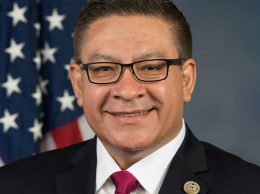Utilities chief touts renewables over nuclear
In order for California to meet its ambitious goals for carbon emissions reductions, environmental reviews might need to be loosened slightly for renewable energy projects, according to the state’s top utilities regulator.
Michael Peevey, the president of the California Public Utilities Commission, gave a wide ranging talk at the Hank Lacayo Institute at CSU Channel Islands on Dec. 10. He spoke about “the enormity of the challenge of de-carbonizing the economy.”
The process will require cutting the Golden State’s carbon emissions from today’s 470 million tons a year to 85 million tons a year by 2050, even as the state’s population swells from 38 million to up to 60 million. While energy efficiency and carbon sequestration will help, renewable energy projects will play a key role and will need to be developed and built.
“I think there has to be some CEQA liberalization,” Peevey said, referring to the California Environmental Quality Act, which requires regulators to identify environmental impacts from projects and ways to mitigate them.
Peevey was careful to emphasize that he does not think California’s environmental reviews are a major obstacle to the development of renewable energy projects. But they could slow down vital efforts to bring renewable energy online. “I do think there are situations where people use environmental laws to obstruct and delay projects. … I feel a great sense of urgency,” he said.
Peevey dismissed nuclear energy as a growth area for carbon-free energy. The state has only two plants, and nuclear power generally costs more to operate than renewables do, Peevey said. “I don’t see much more happening in nuclear,” he said.
Peevey leavened his talk with humor – to describe how the ocean’s chemistry is changing because of excess carbon, he mentioned “too much acid – I’m not talking about the kind of problems I had reading Rolling Stone during the ’60s” – but said the facts are dire. If current carbon emission rates continue for another 15 years, he said, they could push up the global average temperature by two degrees Celsius, which could unleash a wide range of climatic and ecological effects. “We’re moving in to uncharted territory,” he said. “It’s frankly alarming.”
There is, however, good news among the bad. California is blessed with abundant sources of geothermal, wind and solar power, and the state contains some of the nation’s top research centers. He said California is set to meet its renewable energy portfolio standards – a third of the state’s power is supposed to come from renewable sources by 2020 – by a “comfortable margin.” In just four years, the share of renewable in the state’s portfolio climbed from 13 percent to 20 percent.
Peevey stressed the need for the U.S. to develop and then share energy technology. He noted that China consumes 3.3 billion tons of coal a year – half the globe’s consumption. “We all occupy one planet. If we don’t help the Chinese technologically master their use of coal, then what we do almost doesn’t matter,” Peevey said.
Peevey said de-carbonization could be a rich source of jobs. He pointed to a shuttered Toyota factory in the Bay Area that has been revived to produce electric cars for Tesla Motors.
“People who talk doom and gloom about California’s business climate – aspects of that are true. But when it comes to this technology, we are going great guns,” he said. “Government sometimes needs to act and set stretch targets for business.”











